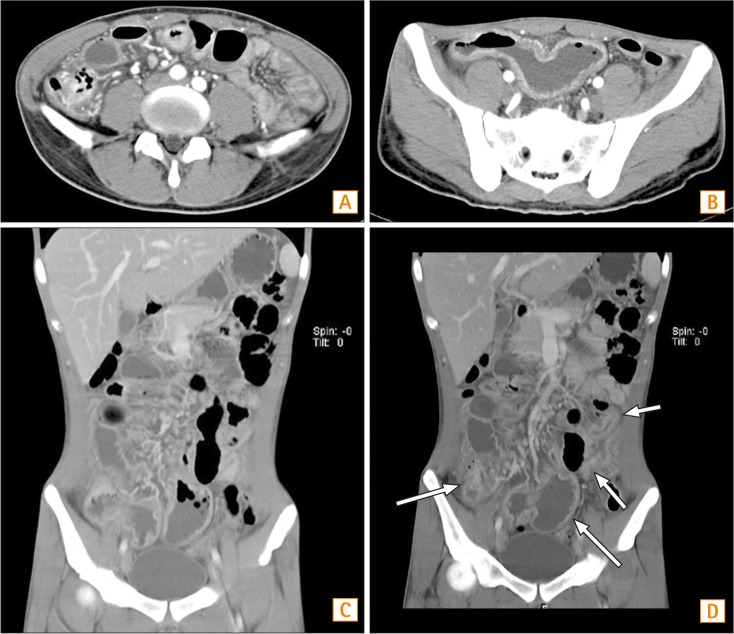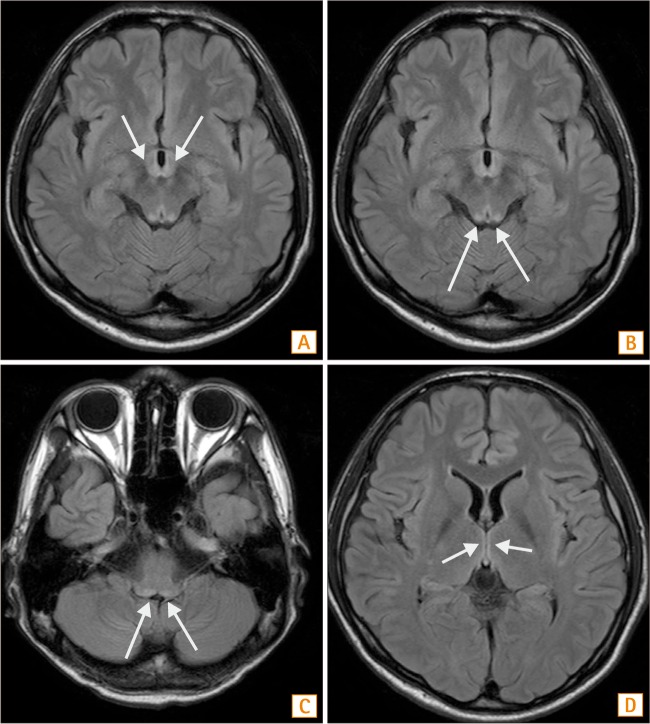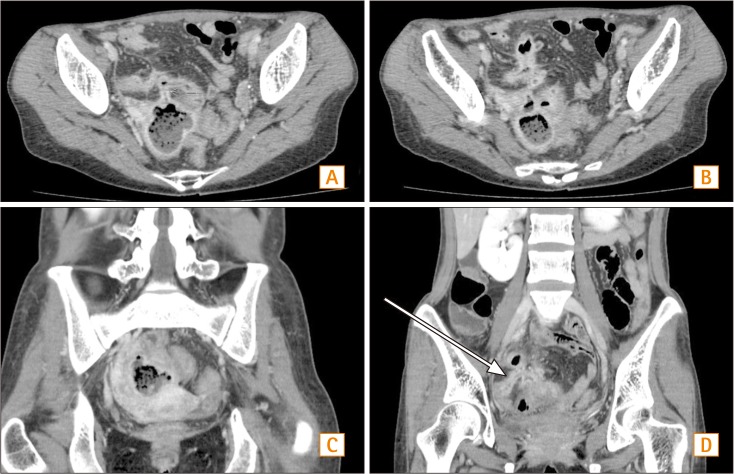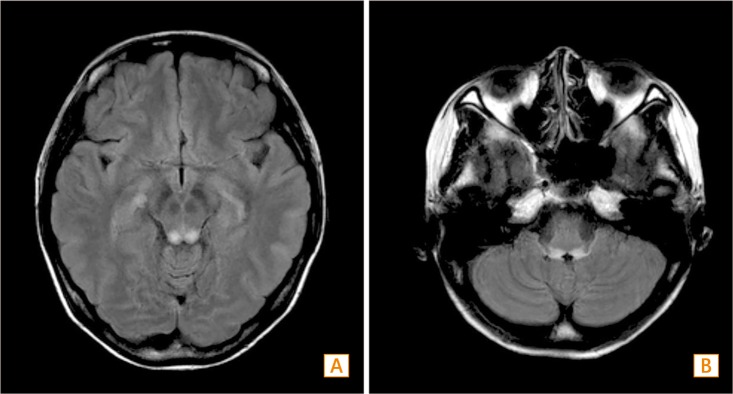Intest Res.
2016 Apr;14(2):191-196. 10.5217/ir.2016.14.2.191.
Wernicke's encephalopathy after total parenteral nutrition in patients with Crohn's disease
- Affiliations
-
- 1Department of Medicine, Samsung Medical Center, Sungkyunkwan University School of Medicine, Seoul, Korea. gisnhong@gmail.com
- KMID: 2425294
- DOI: http://doi.org/10.5217/ir.2016.14.2.191
Abstract
- Micronutrient deficiencies in Crohn's disease (CD) patients are not uncommon and usually result in a combination of reduced dietary intake, disease-related malabsorption, and a catabolic state. Decreased serum thiamine levels are often reported in patients with CD. Wernicke's encephalopathy (WE) is a severe form of thiamine deficiency that can cause serious neurologic complications. Although WE is known to occur frequently in alcoholics, a number of non-alcoholic causes have also been reported. Here, we report two cases of non-alcoholic WE that developed in two severely malnourished CD patients who were supported by prolonged total parenteral nutrition without thiamine supplementation. These patients complained of sudden-onset ophthalmopathy, cerebellar dysfunction, and confusion. Magnetic resonance imaging allowed definitive diagnosis for WE despite poor sensitivity. The intravenous administration of thiamine alleviated the symptoms of WE dramatically. We emphasize the importance of thiamine supplementation for malnourished patients even if they are not alcoholics, especially in those with CD.
Keyword
MeSH Terms
Figure
Cited by 3 articles
-
Vitamin D deficiency is associated with disease activity in patients with Crohn’s disease
Kyoung Ho Ko, You Sun Kim, Bo Kyung Lee, Jong Hyun Choi, Yong Moon Woo, Jin Young Kim, Jeong Seop Moon
Intest Res. 2019;17(1):70-77. doi: 10.5217/ir.2018.00022.Metronidazole-induced encephalopathy in a patient with Crohn's disease
Jihye Kim, Jaeyoung Chun, Jae Yong Park, Seung Wook Hong, Joo Young Lee, Jin Woo Kang, Seongjun Hwang, Sang-Bae Ko, Jong Pil Im, Joo Sung Kim
Intest Res. 2017;15(1):124-129. doi: 10.5217/ir.2017.15.1.124.Micronutrient deficiencies in inflammatory bowel disease: trivial or crucial?
Soon Man Yoon
Intest Res. 2016;14(2):109-110. doi: 10.5217/ir.2016.14.2.109.
Reference
-
1. Zeljko K, Darija VB, Dina LK, Marko B. Wernicke's encephalopathy during parenteral nutrition in a Crohn's disease patient. Nutrition. 2011; 27:503–504. PMID: 21392706.
Article2. Osiezagha K, Ali S, Freeman C, et al. Thiamine deficiency and delirium. Innov Clin Neurosci. 2013; 10:26–32. PMID: 23696956.3. Francini-Pesenti F, Brocadello F, Manara R, Santelli L, Laroni A, Caregaro L. Wernicke's syndrome during parenteral feeding: not an unusual complication. Nutrition. 2009; 25:142–146. PMID: 18929463.
Article4. Galvin R, Bårthen G, Ivashynka A, et al. EFNS guidelines for diagnosis, therapy and prevention of Wernicke encephalopathy. Eur J Neurol. 2010; 17:1408–1418. PMID: 20642790.
Article5. Park J, Oh KW, Koh SH, et al. A case of Crohn's disease with optic neuritis and Wernicke's encephalopathy. J Korean Neurol Assoc. 2007; 25:112–114.6. Filippi J, Al-Jaouni R, Wiroth JB, Hébuterne X, Schneider SM. Nutritional deficiencies in patients with Crohn's disease in remission. Inflamm Bowel Dis. 2006; 12:185–191. PMID: 16534419.
Article7. Kuroki F, Iida M, Tominaga M, et al. Multiple vitamin status in Crohn's disease. Correlation with disease activity. Dig Dis Sci. 1993; 38:1614–1618. PMID: 8359072.8. Busani S, Bonvecchio C, Gaspari A, et al. Wernicke's encephalopathy in a malnourished surgical patient: a difficult diagnosis. BMC Res Notes. 2014; 7:718. DOI: 10.1186/1756-0500-7-718. PMID: 25312751.
Article9. Donnino MW, Vega J, Miller J, Walsh M. Myths and misconceptions of Wernicke's encephalopathy: what every emergency physician should know. Ann Emerg Med. 2007; 50:715–721. PMID: 17681641.
Article10. Eggspühler AW, Bauerfeind P, Dorn T, Siegel AM. Wernicke encephalopathy - a severe neurological complication in a clinically inactive Crohn's disease. Eur Neurol. 2003; 50:184–185. PMID: 14530629.
Article11. Hahn JS, Berquist W, Alcorn DM, Chamberlain L, Bass D. Wernicke encephalopathy and beriberi during total parenteral nutrition attributable to multivitamin infusion shortage. Pediatrics. 1998; 101:E10. PMID: 9417174.
Article12. Larnaout A, El-Euch G, Kchir N, Filali A, Hamida MB, Hentati F. Wernicke's encephalopathy in a patient with Crohn's disease: a pathological study. J Neurol. 2001; 248:57–60. PMID: 11266021.
Article13. Boateng AA, Sriram K, Meguid MM, Crook M. Refeeding syndrome: treatment considerations based on collective analysis of literature case reports. Nutrition. 2010; 26:156–167. PMID: 20122539.
Article14. Kobayashi M, Kaneko A, Matsunaga T. MRI findings in nonalcoholic Wernicke's encephalopathy. Intern Med. 2011; 50:2245–2246. PMID: 21963752.
Article
- Full Text Links
- Actions
-
Cited
- CITED
-
- Close
- Share
- Similar articles
-
- Development of Wernicke’s Encephalopathy during Total Parenteral Nutrition Therapy without Additional Multivitamin Supplementation in a Patient with Intestinal Obstruction: A Case Report
- A case of Crohn's Disease with Optic Neuritis and Wernicke's Encephalopathy
- A Case of Wernicke's Encephalopathy in a Postoperative Patient with Parenteral Nutrition and Temporary Oral Feeding: A Case Report
- Wernicke's encephalopathy in a patient with masticator and parapharyngeal space abscess: a case report
- Two Cases of Wernicke's Encephalopathy in Young Age Patients Receiving Allogeneic Hematopoietic Stem Cell Transplantation





